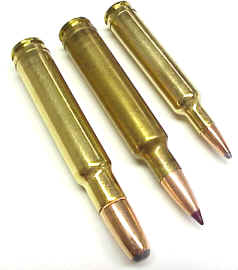 I don’t know what the fascination is with big bore guns, but I know a lot of people share that fascination. I also know what some people believe is the inference; but I tend to agree with the notion, “Sometimes a cigar is just a cigar”. Personally, I think the basis for the interest in big guns stems from our appreciation for anything that represents pushing the limits.
I don’t know what the fascination is with big bore guns, but I know a lot of people share that fascination. I also know what some people believe is the inference; but I tend to agree with the notion, “Sometimes a cigar is just a cigar”. Personally, I think the basis for the interest in big guns stems from our appreciation for anything that represents pushing the limits.
As society changes, various constraints stifle our ability to exercise our imagination, restricting our freedom of activity, we look for other creative outlets. Given a narrow strip of land, and a few hundred bucks or so worth of equipment, we can make noise, burn powder, throw lead, and punch holes in paper in a truly spectacular fashion.
Working with big guns is really no different than building a fast car, putting together a fast computer, running a fast mile…. Well, the EPA took most of my cars off the street, in my job I I work with fast computers enough to make them boring and a prodigious belly of maturity has all but eliminated jogging from my daily routine, so big guns it is. If you like these types of firearms, you’ll eventually end up with a Weatherby, or attempt to sell your home to finance the purchase of a fine British double rifle. Since I like guns that can shoot farther than 100 yards, and my wife seems attached to the idea of owning a home, I felt a Weatherby would do just fine.
Weatherby….wood or fantastic plastic ?
I saw the spec for the .338-378 when it was first introduced, I ran down to the store to get one and left the premises with a very functional piece of machinery – quite different from the typical slick and shiny Mark V Deluxe. A Weatherby, in Accumark form, is an acquired taste; spackled gray, black fluted satin finished stainless barrel, capped with a muzzle brake. After a little shooting experience with the gun, I liked it so much I went right back and picked up an Ultralight; yet another fiberglass stocked gun, only a little lighter and a lesser cartridge. My wife adopted this little .257 magnum about 3 days after its arrival, so I began looking for another Weatherby. I wanted something with more punch than the .338-378 and I wanted something with a real wood stock.
I spent some time analyzing .378, .416 and .460 external ballistics. The .378 offers little over the .338-378. The .338 shoot flatter, retains more energy at longer distances and presents a very broad selection of bullet types and weights. With the exception of one bullet weight, the .460 offers no kinetic energy advantage at 300 yards and beyond over the .338, and bullet drop is three times greater. The .416 Weatherby had something more to offer. With bullet weights generally available from 325 to 410 grain, the .416 falls ballistically right between the .338-378 and the .460. More so, there are some excellent spitzer type bullets made in this bore size that top a .500 BC, like the Barnes X 350 grain bullet – Even in a factory load it produces over 6300 ft/lbs of muzzle energy, and holding onto over 3000 out past 500 yards. With these types of numbers to play with, I went with the .416.
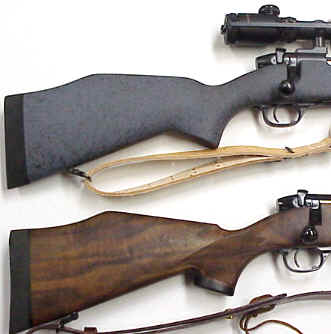 I like wood stocks much better than fiberglass. I don’t care if fiberglass is suppose to be more stable, and stand up better to inclement weather and temperature extremes. I also don’t like stocks with a gloss finish. Basically, that picky criteria left me with the Euromark model, a Mark V with an oil finished stock and matte metal finish.
I like wood stocks much better than fiberglass. I don’t care if fiberglass is suppose to be more stable, and stand up better to inclement weather and temperature extremes. I also don’t like stocks with a gloss finish. Basically, that picky criteria left me with the Euromark model, a Mark V with an oil finished stock and matte metal finish.
Of course, when I tried to buy one, I quickly found there weren’t a lot of Euromark .416’s floating around out there. I called Weatherby, very nice folks, to find out what the factory lead time was on a new order for this type of rifle. I was told Weatherby had rejected a shipment of wood stocks as being substandard quality, and had not shipped a wood stocked product, other than previously inventoried rifles, for two months. However, they were now ready to resume production and lead time for delivery would be approximately 6 – 8 weeks. That was the status as of first week in January. Unfortunately, I also found the retail price increased 30% from December to January. I shopped around in the Bay area and found Reeds was selling at enough of a discount for me to go ahead and make the purchase. In fact, Reeds has pretty much become my source of firearms and a lot of reloading supplies.
Associated Costs
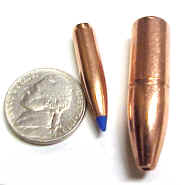 With the gun on order I went on to accumulate all of the other material I would need. As suggested by the picture on the right, there is a significant difference between loading for the .257 and the .416 bore and I wasn’t sure how many of the .416 items would be readily available.
With the gun on order I went on to accumulate all of the other material I would need. As suggested by the picture on the right, there is a significant difference between loading for the .257 and the .416 bore and I wasn’t sure how many of the .416 items would be readily available.
I was surprised to find Midway USA could produce all of the RCBS parts; dies, pullers, reamers, trimmers, bullets, and brass as quickly as similar items for more standard, or more popular cartridges. There is somewhat of a cost penalty affixed to the large cartridge, but only in some areas. The trimmers, reamers, and collet pullers are the same price as smaller calibers versions. Bullets and die sets are more costly.
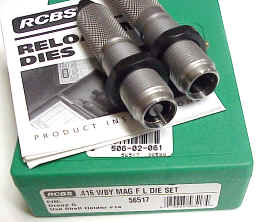 I believe the cost of loading dies is related more to popularity than physical size; the more popular the set, the fewer production setups have to be done and the longer the production runs. Also, the initial cost of tooling gets spread over many more units – all equate to lower costs and correspondingly lower price. The .416 Weatherby 2 die set street price is $75. The .45-70, a large 3 die set of greater popularity is $35. The .460 Weatherby 2 dies set is only $45, but the two die .45-90 is $88.
I believe the cost of loading dies is related more to popularity than physical size; the more popular the set, the fewer production setups have to be done and the longer the production runs. Also, the initial cost of tooling gets spread over many more units – all equate to lower costs and correspondingly lower price. The .416 Weatherby 2 die set street price is $75. The .45-70, a large 3 die set of greater popularity is $35. The .460 Weatherby 2 dies set is only $45, but the two die .45-90 is $88.
The second increased cost area is bullets. I use to gripe about .338 caliber bullets, now they are starting to look like blue light specials. Quality hunting bullets run approximately $30/50 for the .338 bore and $40/50 for the .416 bore. In comparison, my hunting loads for my 7mm mag use $20/100 bullets. Making the leap from 2 cents to 80 cents is not without consternation, but the cost of new brass and ammo may bring on hysteria.
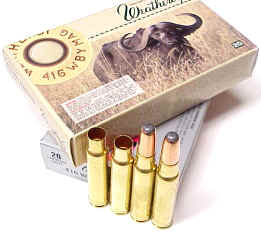 20 pieces of virgin Norma manufactured Weatherby brass runs about $40. Loaded ammo runs between $90 and $105, depending on the specific types of bullets loaded. In this case I picked up the economical 400 grain round nose express cartridges for $90. The picture of the cape buffalo on the box will come in handy, as I am sure the cost of gun and ammo will prevent me from actually seeing one in the wild. Irony ? Perhaps.
20 pieces of virgin Norma manufactured Weatherby brass runs about $40. Loaded ammo runs between $90 and $105, depending on the specific types of bullets loaded. In this case I picked up the economical 400 grain round nose express cartridges for $90. The picture of the cape buffalo on the box will come in handy, as I am sure the cost of gun and ammo will prevent me from actually seeing one in the wild. Irony ? Perhaps.
Powder requirements are about 50% – 70% greater than most .375 H&H based cartridges, but the good news is magnum rifle primers are no more costly for the .416. There is an upside to all of this cost nonsense. I figure I can get 60 rounds to a pound of slow burning powder, about 26 cents per round. Brass will last 10 reloads at least; 20 cents per round. Excellent bullets come in at about 80 cents per, and who cares what primers cost – they’re dirt cheap. So let me see…..about $1.30 per (including primers) or $26 per box for some serious ammo. The real economic key here however has nothing to do with component cost, it’s recoil. Recoil is so severe it will smack the shooter stupid, which interprets into no more than 2 boxes of ammo being consumed during any given year.
Oh, you meant delivery lead time….
Okay, I was ready, every piece of equipment and accessory in place but one – the gun hadn’t shown up. Two month had gone by and I noticed the special phone I had installed just to take the “You gun’s in” call had not rung. A quick check with Weatherby indicated they had the order, but no ship date. I quickly covered the baseline information, “You said 6 – 8 weeks, over 8 weeks have passed, no gun in sight, what do you mean by ‘no schedule date’ ?” Well, it seemed while the great walnut tree stock shortage had been resolved, the Euromark matte black finished barreled action had not. There was a chance this assembly would arrive from Weatherby’s vendor during the latter part of June, a full eight months after I initially attempted to order this gem. Fortunately, they did have a gloss blued .416 barreled action in stock, and a very helpful sales rep offered to combined the gloss action with the Euromark oil finished stock to arrive at one complete rifle. This, of course, added to the new gun anticipation, because I couldn’t imagine if the gun would be nice, or butt ugly. At least I knew it would be unique.
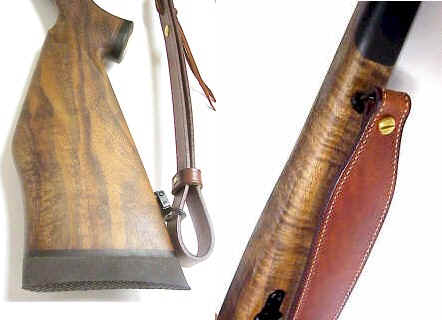
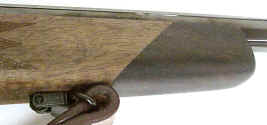 My amateurish photography can’t do justice to the gun’s appearance. I can honestly say, when it came out of the box at Reeds two weeks after the Weatherby call, it drew a crowd – even sales people and experienced Weatherby owners. The wood grain is beautiful. It’s dark enough to show grain and tiger tail, without being too dark, enough figure to stand out, but not so much the forearm will begin walking around and adversely effect accuracy. The ebony grip cap and forend have no contrasting spacer, as used on the Mark V Deluxe, and all of the checkering is cleanly cut and conservative in appearance. Of course the grip cap has the tradition Weatherby maple wood diamond inlay.
My amateurish photography can’t do justice to the gun’s appearance. I can honestly say, when it came out of the box at Reeds two weeks after the Weatherby call, it drew a crowd – even sales people and experienced Weatherby owners. The wood grain is beautiful. It’s dark enough to show grain and tiger tail, without being too dark, enough figure to stand out, but not so much the forearm will begin walking around and adversely effect accuracy. The ebony grip cap and forend have no contrasting spacer, as used on the Mark V Deluxe, and all of the checkering is cleanly cut and conservative in appearance. Of course the grip cap has the tradition Weatherby maple wood diamond inlay.

The metal work is excellent quality, clean edges, uniform finish and close fit to wood parts where appropriate. The gloss blue looked correct with the oil finished stock, probably saving the gun from having too much of a utility appearance. The muzzle is shown with the brake removed and the thread protecting cap in place, a configuration that will actually see daylight for only one or two rounds. I’ve said, on many occasions, that Weatherby’s are designed to manage heavy recoil and I am sure this .416 will be no different. Besides, the real culprit isn’t recoil as much as extraordinary muzzle climb that leaves the muzzle in a position more appropriate for duck hunting, after each round is fired.
The Plan
At the moment I’ve got four or five projects in the works: writing up the handload article for the .257 Weatherby, finishing the electronic powder dispenser evaluation, picking up a scope for the new gun, getting the .416 to the range to collect some preliminary data, and working up handloads for the .416. Compounding my schedule problems, there’s this work for a living thing in there somewhere, and I may have gotten caught up in the big bore moment when I picked up the Weatherby and purchased a Marlin .45-70 guide gun. So next week, or the week after for sure, I will definitely write about one or more of those things. No, not work. I definitely won’t write about work.
Here’s some more baby pictures, in case your interested. The picture is a little funky, it’s actually a composite of three images cobbled together. The top gun is a little Ultralight .257 Weatherby which suggests the .416 isn’t all that big of package. In fact they were so similar in size, I dragged out the scale and weighed the Euromark and found it weighed only 8 1/2 lbs, including the sling. This should be fun.
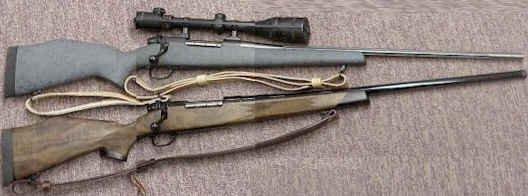
Thanks,Joe

Email Notification